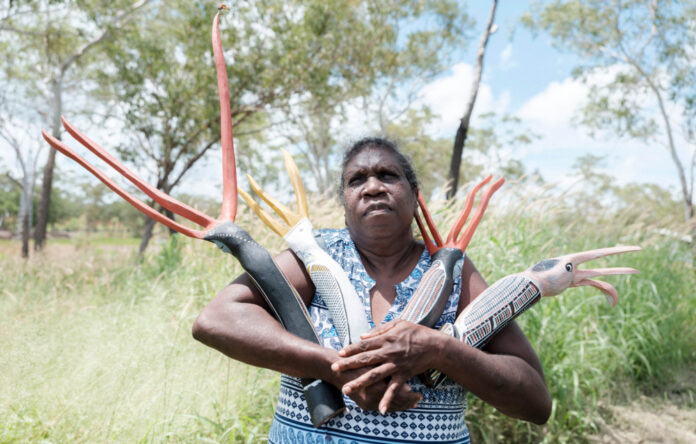[ad_1]
A Vibrant Exhibition Of 38 Hand-Carved + Painted Birds At Laundry Gallery
Art

Artist Irene Henry with four of her birds, which she creates with her husband Harold Goodman. Photo – Alana Holmberg

Irene has been carving and painting birds for 23 years! Photo – Alana Holmberg

Last year Irene and Harold were finalists in the National Aboriginal and Torres Strait Islander Art Award (NATSIAA). Photo – Alana Holmberg

This year, Irene’s goal is to make 200 birds. Photo – Alana Holmberg

Harold carves the birds, while Irene paints. Photo – Alana Holmberg

Together they create lurrilmal (black cockatoo), ditjgan (sulfur crested cockatoo), and bilarrkbilarrk (galah). Photo – Alana Holmberg

Irene and Harold are currently exhibiting at Laundry Gallery! Photo – Alana Holmberg

It’s the couple’s first solo show; ‘Ditjgan (White Cockatoo)’, in collaboration with Marrawuddi Arts and Culture. Photo – Alana Holmberg

The show features 38 birds. Photo – Alana Holmberg

Find the catalogue here! Photo – Alana Holmberg
From January to March in the Top End, NT, the Wet Season is in full swing. This year has been a big one, with huge monsoonal storms breaking up hot languid days.
But, this extreme weather hasn’t kept Irene Henry and her husband Harold Goodman from their work. In fact, they’ve been busier than ever.
‘This year we are making 200 birds. Last year we maybe made 100,’ she says.
Last year the pair, who are childhood sweethearts, were finalists in the National Aboriginal and Torres Strait Islander Art Award (NATSIAA), a feat Irene is, rightly, very proud of.
Irene is Tiwi, meaning, as she says, painting and art is in her blood. Irene’s sister was a finalist in the NATSIAA in 1992, her cousin and niece are artists, and her granddaughter is taking up the mantle as well.
This is her story.
Irene began carving black–necked storks (Jabiru) in 2000 – a skill she learnt by observing the work of her cousin brother Sebastian Tipaloura as he carved small pigeons.
‘One day I sort of done what he did and then I start carving cockatoos, kookaburra. I was watching and I just picked it up really quick because it’s in my blood. Then the design, my niece, she’s a painter, famous painter, Rhonda [Henry]. And I used to see her do it and then I picked it up really quick.’
As she developed the craft, Harold started to carve small birds too. They worked in a similar style to old Sebastian before them, but it wasn’t long before Irene’s sharp and ambitious creativity pressed Harold to work on a new design of their own. Still inspired by Irene’s Tiwi heritage they landed on black cockatoos, an important bird in Tiwi ceremony, depicted in carvings from the islands.
‘It is different style than Tiwi cockatoos… Harold uses woolybutt or stringybark. He makes the crest different. The one from Tiwi they make it small, a small crest. Our ones, he makes it more bigger, longer… They are very fancy with the crests too.”
Harold and Irene work predominantly from their home at Kapalga outstation in Kakadu National Park, where they have lived most of their lives. Irene’s mother is Minitja of the Limilgnan language group, making her the Djungkay (cultural manager) for Minitja Country, which lies on the lower Mary River region. Together, the couple forage the surrounding bush for their birds, walking across country to find the right pieces of wood for each new character.
‘When we go out to cut, we’ll see a log on the ground. And we can just go and we can just picture that bird already. So then Harold says, “cut this, cut that”. And then when he takes it back, he just makes it the way he wants it to be… He does it with the grinder, you know, makes it really smooth… then we get the sandpaper and smooth it down, so it won’t be too rough.
I do the painting on them… and sometimes when I get tired my niece starts to [paint] too, you know, she helps me paint, we work together. And my granddaughter, she’s a little artist. Everyone’s doing art.’
With many helping hands, 200 birds are within Irene’s enthusiastic reach. As is the passing on of stories and craftsmanship, the old stories to new hands, for many more hot wet seasons to come.
Irene and Harold’s first solo show ‘Ditjgan (White Cockatoo)’, is showing now at Laundry Gallery in collaboration with Marrawuddi Arts and Culture, showcasing 38 birds including; black cockatoos, sulfur crested cockatoos, and galahs.
[ad_2]
thedesignfiles.net










